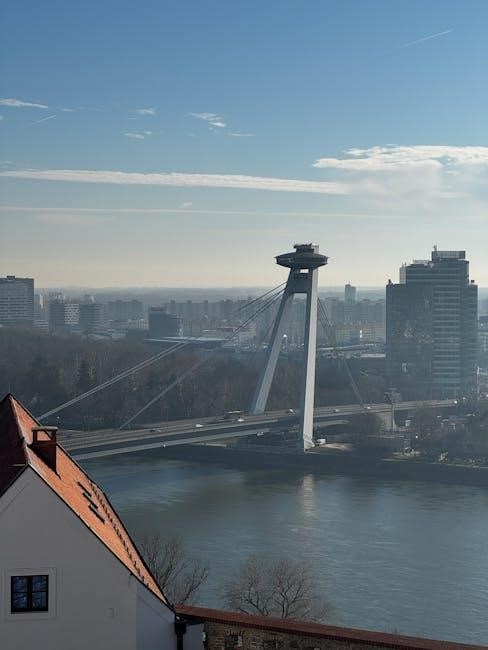
cataclysm engineering guide
Cataclysm engineering focuses on preparing for and responding to large-scale disasters, blending science, technology, and strategy to mitigate impacts on infrastructure and communities globally.
1.1 Definition and Scope
Cataclysm engineering is an interdisciplinary field focused on understanding and mitigating large-scale disasters, such as earthquakes, floods, and volcanic eruptions. It integrates principles from structural, geotechnical, and environmental engineering to develop resilient infrastructure and strategies for emergency response. The scope extends to both natural and anthropogenic disasters, emphasizing risk assessment, design innovation, and community preparedness. By addressing the physical and social impacts of catastrophes, cataclysm engineering aims to reduce vulnerability and enhance societal resilience. Its applications span urban planning, material science, and technological advancements, ensuring a comprehensive approach to disaster management and recovery.
1.2 Importance in Modern Engineering
Cataclysm engineering is vital in addressing the increasing frequency and severity of disasters due to climate change and urbanization. By integrating structural, geotechnical, and environmental engineering, it ensures infrastructure resilience and protects communities. The field’s emphasis on risk assessment, sustainable design, and emergency preparedness makes it indispensable for modern societies. As global challenges escalate, cataclysm engineering plays a critical role in safeguarding human lives, economies, and ecosystems, ensuring long-term sustainability and adaptability in the face of unpredictable and catastrophic events.
1.3 Overview of the Guide
This guide provides a comprehensive exploration of cataclysm engineering, offering insights into its core principles, methodologies, and applications. It covers fundamental concepts, risk assessment strategies, and essential engineering skills required to address catastrophic events. The guide also delves into design considerations, mitigation techniques, and technological innovations, supported by case studies and lessons learned. Additionally, it emphasizes sustainability, ethical implications, and emergency response planning, serving as a valuable resource for engineers, policymakers, and researchers aiming to enhance disaster resilience and adaptability in an increasingly vulnerable world.
Fundamental Concepts of Cataclysm Engineering
Cataclysm engineering focuses on understanding and mitigating large-scale disasters using engineering principles, risk assessments, and strategies to protect infrastructure and communities from catastrophic events.
2.1 Understanding Cataclysms
Cataclysms are large-scale, disruptive events such as earthquakes, hurricanes, or tsunamis that significantly impact ecosystems and human societies. They can be natural or anthropogenic, often causing widespread destruction. Understanding their origins, patterns, and potential consequences is critical for effective engineering strategies. Cataclysms vary in intensity and predictability, requiring interdisciplinary approaches to mitigate their effects. Recent research, such as studies published in Case Studies in Thermal Engineering, highlights the importance of analyzing these events to develop resilient infrastructure and adaptive systems. This knowledge forms the foundation of cataclysm engineering, enabling proactive solutions to protect communities and environments.
2.2 Engineering Principles
Engineering principles in cataclysm engineering emphasize resilience, adaptability, and sustainability. These principles guide the design and implementation of systems to withstand or recover from catastrophic events. Key concepts include load redistribution, energy absorption, and material durability. Modern approaches integrate advanced materials and technologies, such as smart structures and adaptive systems. These principles ensure that infrastructure and communities can endure extreme conditions while minimizing damage. By applying these engineering principles, professionals aim to create solutions that protect lives and reduce economic losses during and after disasters.
2.3 Risk Assessment
Risk assessment in cataclysm engineering involves identifying and evaluating potential hazards to determine their likelihood and impact. This process utilizes probabilistic models, historical data, and simulation tools to predict disaster scenarios. Engineers analyze factors such as environmental conditions, infrastructure vulnerability, and societal resilience. By prioritizing risks based on severity and likelihood, effective mitigation strategies can be developed. Continuous monitoring and adaptation of risk assessments ensure preparedness for evolving threats, enabling proactive measures to safeguard communities and infrastructure from catastrophic events.

Core Engineering Skills Required
Cataclysm engineering demands expertise in structural, geotechnical, and environmental engineering to design resilient systems. Strong analytical and problem-solving skills are essential for addressing complex challenges effectively.
3.1 Structural Engineering
Structural engineering is critical in cataclysm engineering, focusing on designing buildings and infrastructure to withstand extreme forces like earthquakes, floods, and high winds. Engineers use advanced materials and load calculations to ensure stability. Dynamic analysis and simulation tools predict structural behavior under stress. Collaboration with geotechnical engineers ensures foundations are secure. Modern research, as seen in publications like Case Studies in Thermal Engineering, highlights innovations in resilient design. These practices minimize damage and enhance safety, protecting both lives and property during catastrophic events. Structural engineering’s role is vital in creating durable, adaptable structures for disaster-prone areas.
3.2 Geotechnical Engineering
Geotechnical engineering plays a pivotal role in cataclysm engineering by analyzing soil, rock, and groundwater behavior under extreme conditions. It focuses on ensuring the stability of foundations, slopes, and underground structures during earthquakes, floods, and landslides. Engineers employ advanced techniques like ground reinforcement and soil stabilization to prevent failures. Research in journals such as Case Studies in Thermal Engineering highlights innovations in geotechnical design for disaster resilience. By understanding terrain dynamics, geotechnical engineers develop solutions to mitigate landslide risks, erosion, and liquefaction, safeguarding infrastructure and communities from catastrophic ground-related failures.
3.3 Environmental Engineering
Environmental engineering in cataclysm engineering focuses on mitigating the ecological impacts of disasters. It involves designing sustainable systems to manage water resources, waste, and pollution. Engineers develop strategies to protect ecosystems during and after catastrophes, such as floodwater diversion systems and soil conservation techniques. Recent studies, like those in Case Studies in Thermal Engineering, highlight advancements in eco-friendly designs to reduce environmental degradation. By integrating green technologies, environmental engineers ensure that disaster recovery aligns with long-term sustainability goals, balancing human needs with ecological preservation to create resilient communities.

Cataclysm Analysis and Design
Cataclysm analysis involves studying natural and anthropogenic disasters to design resilient systems. Recent advancements in thermal management systems, as noted in Case Studies in Thermal Engineering, enhance disaster preparedness and mitigation strategies.
4.1 Natural Cataclysms
Natural cataclysms, such as earthquakes, hurricanes, floods, and volcanic eruptions, pose significant threats to infrastructure and communities. Engineers must analyze these events to design resilient systems. Recent research, including work by Mehdi Kabir in Case Studies in Thermal Engineering, highlights advancements in thermal management systems to enhance disaster preparedness. Understanding the dynamics of natural disasters is crucial for developing strategies to mitigate their impacts. By studying historical patterns and leveraging modern technologies, engineers can create solutions that reduce vulnerability and enhance community safety. This approach ensures sustainable and adaptive infrastructure design in the face of natural cataclysms.
4.2 Anthropogenic Cataclysms
Anthropogenic cataclysms, such as industrial accidents, nuclear meltdowns, and large-scale warfare, result from human activities. These events often have devastating consequences, requiring specialized engineering solutions. Recent studies, including work by Mehdi Kabir in Case Studies in Thermal Engineering, emphasize the importance of understanding thermal dynamics in such scenarios. Engineers must develop strategies to mitigate risks, such as implementing fail-safe systems and improving disaster response plans. Addressing anthropogenic cataclysms involves a multidisciplinary approach, combining technical expertise with policy measures to prevent and manage these man-made disasters effectively, ensuring global safety and sustainability.
4.3 Design Considerations
Design considerations in cataclysm engineering prioritize resilience, adaptability, and sustainability. Engineers must integrate advanced materials and technologies to withstand extreme forces. Recent research by Mehdi Kabir in Case Studies in Thermal Engineering highlights the role of thermal management in structural integrity. Designs should incorporate flexible systems that adapt to dynamic conditions, ensuring minimal damage and rapid recovery. Additionally, environmental impact assessments are crucial to avoid exacerbating disasters. Collaborative efforts between engineers, policymakers, and communities ensure that designs are practical, scalable, and aligned with global safety standards, fostering a proactive approach to disaster mitigation and recovery.

Mitigation and Adaptation Strategies
Mitigation and adaptation strategies in cataclysm engineering focus on reducing risks and enhancing resilience. These strategies involve proactive planning, infrastructure reinforcement, and community preparedness to minimize disaster impacts.
5.1 Infrastructure Resilience
Infrastructure resilience is critical in cataclysm engineering, focusing on designing and retrofitting structures to withstand extreme events. This involves using advanced materials, robust designs, and smart technologies to ensure systems remain functional during and after disasters. Recent studies, such as those published in Case Studies in Thermal Engineering, highlight the importance of integrating thermal management and stress-resistant components. By prioritizing resilience, communities can minimize damage, reduce recovery times, and save lives. Ongoing research and innovation are essential to stay ahead of evolving threats and improve infrastructure durability globally.
5.2 Community Preparedness
Community preparedness is a cornerstone of cataclysm engineering, emphasizing education, emergency planning, and collective action to enhance disaster readiness. By fostering awareness and training, communities can reduce vulnerabilities and improve response capabilities. Strong communication networks and accessible resources are vital for ensuring all members, including vulnerable populations, are equipped to face disasters. Recent research, such as studies published in Case Studies in Thermal Engineering, underscores the importance of proactive strategies. Empowering communities through knowledge and collaboration not only saves lives but also accelerates recovery, making preparedness a critical component of resilience-building efforts.
5.3 Technological Innovations
Technological innovations play a pivotal role in advancing cataclysm engineering, offering cutting-edge solutions to mitigate and respond to disasters. Recent advancements include AI-driven predictive models, IoT-enabled early warning systems, and smart materials designed to withstand extreme conditions. For instance, researchers like Assistant Professor Mehdi Kabir have contributed to thermal engineering innovations, as highlighted in Case Studies in Thermal Engineering. These technologies enhance preparedness, improve response efficiency, and reduce infrastructure vulnerabilities. By integrating such innovations, engineers can create more resilient systems, ensuring safer and more sustainable communities in the face of catastrophic events.
Case Studies in Cataclysm Engineering
Case studies provide real-world insights into catastrophic events, offering lessons on preparation, response, and recovery strategies, enhancing future engineering practices and community resilience.
6.1 Historical Disasters
Historical disasters, such as the 1906 San Francisco earthquake and the 2004 Indian Ocean tsunami, provide critical insights into catastrophic events. These events highlight the devastating impact of natural catastrophes on infrastructure and communities. By analyzing past disasters, engineers can identify patterns and develop strategies to mitigate future risks. For instance, the 1906 earthquake led to the establishment of modern seismic design principles, while the 2004 tsunami underscored the importance of early warning systems. Studying these events is essential for refining cataclysm engineering practices and enhancing resilience in the face of unpredictable natural phenomena.
6.2 Modern Applications
Modern applications of cataclysm engineering focus on integrating advanced technologies to enhance disaster preparedness and response. The development of smart infrastructure, such as sensor-equipped buildings and early warning systems, has revolutionized the field. Recent advancements in real-time monitoring and predictive analytics enable engineers to identify potential risks and implement mitigation strategies proactively. For example, the use of IoT devices in flood-prone areas has improved evacuation planning and resource allocation. These innovations not only reduce the impact of disasters but also foster more resilient communities, aligning with the principles of sustainable and adaptive engineering practices.
6.3 Lessons Learned
Lessons learned from historical and modern cataclysms highlight the importance of proactive planning and community resilience. Historical disasters, such as earthquakes and floods, have taught engineers the value of adaptive infrastructure designs. Modern applications, including smart technologies and data analytics, have improved disaster response and recovery. These insights emphasize the need for interdisciplinary collaboration and continuous innovation. By studying past events, engineers can develop more effective strategies to mitigate future risks, ensuring safer and more sustainable communities. These lessons serve as a foundation for advancing cataclysm engineering practices globally.

The Role of Technology
Technology plays a crucial role in enhancing resilience and preparedness, utilizing advanced materials, simulation tools, and IoT applications to predict and mitigate cataclysmic impacts effectively.
7.1 Advanced Materials
Advanced materials are revolutionizing cataclysm engineering by providing lightweight, high-strength, and durable solutions. Materials like high-strength concrete, fiber-reinforced polymers, and shape-memory alloys enhance structural resilience. These materials can withstand extreme conditions, such as earthquakes or floods, reducing damage and improving safety. Additionally, self-healing materials and smart composites are being developed to autonomously repair infrastructure post-disaster. Their adaptability and sustainability make them critical in designing resilient systems, ensuring structures can endure and recover from catastrophic events more effectively while minimizing environmental impact.
7.2 Simulation Tools
Simulation tools are essential in cataclysm engineering for predicting and mitigating disaster impacts. Finite element analysis and computational fluid dynamics are widely used to model structural behavior under extreme loads. These tools enable engineers to test virtual prototypes, identifying vulnerabilities and optimizing designs. Real-time data integration allows for accurate scenario modeling, such as earthquake waves or flood patterns. Advanced simulations enhance preparedness by visualizing potential damage, guiding evacuation plans, and ensuring infrastructure resilience. They are indispensable for designing safer, adaptive systems and saving lives in high-risk environments.
7.3 IoT Applications
IoT applications play a pivotal role in cataclysm engineering by enabling real-time monitoring and data collection. Sensors embedded in infrastructure and environments provide critical insights into structural integrity, environmental conditions, and potential risks. IoT devices facilitate early warning systems for earthquakes, floods, and storms, allowing for timely evacuations and resource mobilization. Smart systems optimize emergency response by tracking damage and resource allocation. IoT also supports post-disaster recovery by assessing infrastructure health and managing reconstruction efforts. These technologies enhance resilience, improve decision-making, and reduce the impact of cataclysms on communities and ecosystems.

Sustainability and Environmental Considerations
Sustainability in cataclysm engineering involves integrating eco-friendly practices and materials to minimize environmental impact during disaster recovery and preparedness, ensuring long-term resilience and ecological balance.
8.1 Green Practices
Green practices in cataclysm engineering emphasize sustainable methods to reduce environmental impact. This includes using recycled materials, energy-efficient systems, and renewable resources during disaster recovery. By prioritizing eco-friendly construction techniques and minimizing waste, engineers can create resilient infrastructure while preserving natural resources. Green practices also involve integrating vegetation in designs to mitigate soil erosion and improve air quality. These sustainable approaches not only align with global environmental goals but also enhance community resilience, ensuring that post-disaster reconstruction supports both human and ecological well-being for future generations.
8.2 Eco-Friendly Designs
Eco-friendly designs in cataclysm engineering focus on creating sustainable infrastructure that harmonizes with the environment. These designs incorporate natural materials, minimize resource consumption, and reduce long-term environmental degradation. By integrating green infrastructure, such as permeable pavements and bioswales, engineers can enhance disaster resilience while preserving ecosystems. Eco-friendly designs also prioritize energy efficiency and renewable energy sources, ensuring that structures are both resilient and environmentally responsible. These practices not only mitigate the impact of cataclysms but also promote sustainable development, fostering a balance between human safety and ecological health.

Ethical and Social Implications
Cataclysm engineering raises ethical questions about equity in disaster response and resource allocation, while addressing societal trust and cultural preservation during crisis management and infrastructure development.
9.1 Ethical Dilemmas
Cataclysm engineering often involves tough ethical decisions, such as prioritizing resource allocation during disasters or balancing safety with cost efficiency. Engineers must weigh competing values, ensuring equitable access to protective measures and minimizing harm. Additionally, the potential for environmental disruption versus human safety creates moral complexities. Transparency and accountability are crucial to maintain public trust. These dilemmas highlight the need for ethical frameworks to guide decision-making in high-stakes scenarios.
9.2 Social Impact
Cataclysm engineering significantly influences societal dynamics, affecting communities’ resilience and recovery. Effective engineering solutions can foster social cohesion by ensuring equitable access to safety measures. Conversely, poorly designed systems may exacerbate inequalities, disproportionately affecting marginalized groups. The psychological impact of disasters, such as trauma and displacement, must also be addressed. Public perception of engineering interventions plays a crucial role in building trust and cooperation. Ultimately, cataclysm engineering must prioritize human well-being, ensuring that solutions are inclusive and culturally sensitive to promote long-term social stability and recovery.
9.3 Communication Strategies
Effective communication is vital in cataclysm engineering to ensure clarity and coordination during crises. Transparent messaging helps build trust between engineers, authorities, and the public. Accessible communication ensures that all individuals, including those with disabilities, receive critical information. Participatory approaches engage communities in decision-making, fostering collaboration. Utilizing diverse channels, such as social media, broadcasts, and community networks, maximizes reach. Regular updates and feedback mechanisms ensure that information remains relevant and actionable. Clear communication strategies are essential for saving lives, reducing panic, and enabling efficient recovery efforts.

Emergency Response and Recovery
Emergency response and recovery involve coordinated planning, trained personnel, and resilient infrastructure to minimize damage and restore systems after a cataclysm.
10.1 Emergency Planning
Effective emergency planning is critical for mitigating cataclysm impacts. It involves creating detailed response strategies, conducting regular drills, and establishing communication networks. Key components include risk assessments, resource allocation, and evacuation plans. Collaboration between engineers, emergency services, and communities ensures a unified approach. Advanced technologies, such as early warning systems, enhance preparedness. Regular updates to plans based on simulations and real-world scenarios are essential. Proper planning reduces response time, minimizes casualties, and accelerates recovery. It also ensures that critical infrastructure remains functional during crises. A well-structured plan is the cornerstone of resilience in cataclysm engineering.
10.2 Post-Disaster Recovery
Post-disaster recovery in cataclysm engineering focuses on restoring communities and infrastructure. Key steps include damage assessment, debris removal, and rebuilding critical systems. Engineers prioritize infrastructure resilience to prevent future failures. Temporary housing and essential services are established to support affected populations. Collaboration between governments, NGOs, and local communities ensures efficient resource distribution. Psychological support is also vital to aid trauma recovery. Recovery plans incorporate lessons from the disaster to enhance future preparedness. Sustainable practices are integrated to reduce long-term environmental impacts. Effective recovery lays the foundation for rebuilding stronger, more resilient communities.
Cataclysm engineering is crucial for safeguarding communities against disasters. It integrates resilience, sustainability, and innovation to create safer environments for future generations.
11.1 Summary of Key Points
This guide has explored the critical aspects of cataclysm engineering, from understanding cataclysms to developing resilience strategies. Key areas include risk assessment, core engineering skills, and innovative technologies. The importance of sustainability and ethical considerations was emphasized, along with lessons from historical and modern case studies. By integrating advanced materials, simulation tools, and IoT applications, engineers can better prepare for and respond to disasters. Community preparedness and emergency planning are vital for effective recovery. These principles underscore the need for a holistic approach to mitigate the impact of cataclysms and ensure a safer future.
11.2 Final Thoughts
Cataclysm engineering is a vital field that demands innovation, collaboration, and a deep understanding of natural and human-induced disasters. By integrating structural, geotechnical, and environmental expertise, engineers can develop resilient solutions to protect communities and ecosystems. The lessons learned from historical and modern case studies highlight the importance of preparedness and adaptability. As technology advances, the potential to mitigate cataclysms grows, offering hope for a safer and more sustainable future. Engineers play a critical role in safeguarding humanity and the planet, making their contributions indispensable in an ever-evolving world.

Future Directions in Cataclysm Engineering
Future directions lie in advancing materials, AI-driven predictions, and sustainable designs to mitigate disasters, ensuring safer and resilient infrastructure for generations to come.
12.1 Emerging Trends
The field of cataclysm engineering is evolving rapidly, with emerging trends focusing on smart materials, AI-driven disaster prediction, and modular construction designs. Advances in artificial intelligence enable real-time monitoring and predictive analytics for early warning systems. Green infrastructure is gaining traction, integrating natural systems to mitigate disaster impacts; Additionally, 3D printing technology is revolutionizing rapid reconstruction efforts. These innovations are reshaping how engineers design resilient infrastructure, emphasizing adaptability and sustainability. By leveraging these trends, cataclysm engineering aims to enhance community preparedness and reduce long-term recovery times, fostering a more resilient future.
12;2 Research Opportunities
Research in cataclysm engineering is expanding into uncharted territories, offering vast opportunities for innovation. A key focus is enhancing predictive modeling to better anticipate and prepare for disasters. Another area is developing multi-hazard resistant materials that can withstand extreme conditions. Additionally, real-time monitoring systems using IoT and AI are being explored to improve early warning systems. There is also a growing interest in community-centric designs that prioritize social equity and cultural resilience. These research directions aim to bridge gaps in current knowledge, ensuring more effective and inclusive disaster mitigation strategies.

References and Further Reading
For deeper insights, explore academic journals like Nature and Science for cutting-edge research. Key textbooks such as “Disaster Risk Management” by Smith and “Engineering for Catastrophes” by Johnson provide foundational knowledge. Reports from organizations like the United Nations and FEMA offer practical guidelines. Online resources, including tutorials from MIT OpenCourseWare and Harvard’s Disaster Preparedness Program, are invaluable. Visit libraries or access digital platforms like Springer and IEEE for comprehensive access to these materials.
- Smith, J. (2020). Disaster Risk Management. Cambridge University Press.
- Johnson, R. (2019). Engineering for Catastrophes. Wiley.